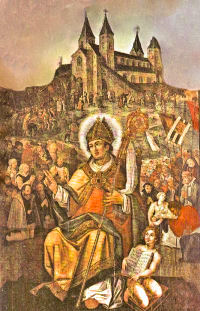St. Wilfrid
St. Wilfrid
 St. Wilfrid was a Northumbrian of noble birth. He was educated at Lindisfarne, and became infected with a love both for learning and the monastic life. When quite a young man he traveled to Canterbury and then to Rome. On his return, he founded monasteries at Ripon and Stamford, and became prominent as the successful protagonist of the Roman customs at the Synod of Whitby, 664 A.D.
St. Wilfrid was a Northumbrian of noble birth. He was educated at Lindisfarne, and became infected with a love both for learning and the monastic life. When quite a young man he traveled to Canterbury and then to Rome. On his return, he founded monasteries at Ripon and Stamford, and became prominent as the successful protagonist of the Roman customs at the Synod of Whitby, 664 A.D.
He was then made Bishop of York, and went to France to be consecrated. In his absence Chad was consecrated and made Bishop of York in his place, and held the see for four years. During this time Wilfrid founded a monastery at Oundle and acted as bishop in Mercia. He was then installed at York by Archbishop Theodore, and ruled the see for nine years. He also founded the Abbey of Hexham. He managed to gain the ill-will of Egfrith, King of Northumbria, and Archbishop Theodore, who divided his diocese in four parts without his knowledge or consent.
He journeyed to Rome, and his appeal was successful, but on his return to Northumbria he was accused of having forged the pope’s bull, and was thrown into prison. After his release he went to Sussex, and for five years preached the Gospel to its pagan inhabitants. When he went there the country was suffering from famine, the result of three years’ drought, and its inhabitants were drowning themselves in despair. Wilfrid gained their goodwill by teaching them to fish.
“By this benefit the bishop gained the affections of them all, and they began more readily to hope for heavenly blessings, since by his help they had already received those which are temporal.” His labors seem to have been abundantly successful, and he added to his success by establishing a monastery at Selsey.
Archbishop Theodore, now on his deathbed, became reconciled to Wilfrid, and even wished to nominate him as his successor in the See of Canterbury. This, however, Wilfrid refused, but used Theodore’s good offices to secure his return to Northumbria.
After a few years his enemies seem to have made his position so difficult that he retired to Mercia, and when St. Chad died he succeeded to his position as Bishop of Lichfield, and labored in that diocese for ten years. He was recalled to be tried by a Northumbrian council of nobles and bishops, was once more condemned, and once more appealed to Rome. Once again his appeal was successful, and this time the Roman judgment was accepted in Northumbria.
The few remaining years of his life were spent in comparative retirement, principally at Hexham and Ripon. His last public act was the consecration of Evesham Abbey; he died on his way home at his monastery at Oundle in the year 709, and was buried at Ripon.
Wilfrid was one of the most versatile and accomplished men of his own or any other age. He was a great builder, a lover of learning, and a musician; he knew how to create splendid effects through art and through religious ceremonial. He was also a founder and a builder in men as well as stones. He was, in fact, a great creative artist.